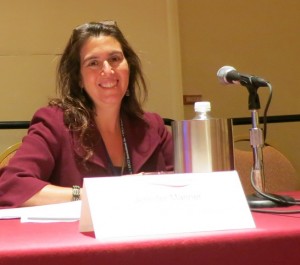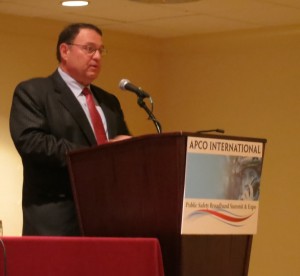True, Nationwide Interoperability Is on the Horizon
“This is quite an exciting time,” said Jennifer A. Manner, deputy bureau chief, Public Safety and Homeland Security Bureau, FCC, during the second annual APCO International Public Safety Broadband Summit and Expo on May 14. “We have a once in a lifetime opportunity to achieve nationwide interoperability for public safety.”
The Broadband Summit brought together technology experts, policy leaders, industry partners, commercial carriers and public safety professionals to educate state and local government personnel on the process of building out the nationwide public safety broadband network authorized and funded by recent legislative action.
H.R. 3630, the Middle Class Tax Relief and Job Creation Act, allocated the D Block Spectrum to public safety and establishes the First Responder Network Authority (FirstNet) to manage the build out of a nationwide public safety broadband network, a $7 billion grant program to fund the build out, an additional $135 million grant program to assist state and local planning and implementation, $115 million for Next Generation 9-1-1, and the give back of T-Band public safety spectrum between 470 and 512 MHz.
During the opening keynote on Monday, May 14, Lawrence E. Strickling, assistant secretary for communications and information at the Department of Commerce and administrator of the NTIA, said, “At the Department of Commerce’s National Telecommunications and Information Administration (NTIA), we are hard at work interpreting and implementing the law to meet the requirement that we stand up the First Responder Network Authority—or FirstNet—by Aug. 20.”
He continued, “As we talk to industry leaders about this project, we are constantly told that the first order of business for FirstNet is to understand the needs of the customers—the first responders who will be depending on the performance of this network in their day-to-day work as well as in times of national crisis. At every step of the way, we will keep this mandate in the front of our thinking about setting up this new endeavor.”
Strickling announced that the NTIA had just issued a Request for Information (RFI) to get input from public safety organizations, states, local governments and anyone else who has ideas or advice on how to best set up the grants program.
On Tuesday, May 19, Laura M. Pettus, NTIA program manager for public safety grants, went into detail on the type of information the administration is looking for in advance of establishing the grant programs.
Pettus also discussed how the build out of the network will be funded.
Some funds will be immediately available. Section 6207 of the Act grants NTIA borrowing authority not to exceed $2B to implement Subtitle B—Governance of Public Safety Spectrum. Section 6301 of the Act grants NTIA borrowing authority not to exceed $135M to implement Section 6302—State and Local Implementation. In each case, NTIA borrows the initial funds from the general fund of the Treasury prior to the deposit of auction proceeds into the Public Safety Trust Fund (PSTF). Amounts deposited in the PSTF are funds from the incentive auctions to be carried out by the FCC under 47 U.S.C. § 309(j)(8)(G) or the auction of spectrum pursuant to Section 6401.
Pettus noted that PSTF may not be the first fund to receive auction proceeds.
“FirstNet is almost here,” said Jeff Cohen, APCO International chief counsel for law and policy. “It represents a new way of doing business for public safety.”
Every speaker emphasized the importance of continued input from public safety as the network is designed and implemented.
“We can’t push decisions now at the risk of long-term goals,” said Chris Essid, director of the Office of Emergency Communications (OEC), Department of Homeland Security. “We need to remain united and continue working to meet our goal.”
The OEC’s mission is to ensure that the voices of local and state stakeholders are heard every step of the way, said Essid.
“States should already be working to include broadband in their statewide plan,” said Essid.

Public safety personnel from every strata were present at the 2nd Annual APCO International Broadband Summit. Photo Keri Losavio
What will success look like? Tom Power, deputy chief technology officer, Executive Office of the President, had an answer: “The folks on the ground will have a robust, interoperable network based on a national architecture.”
Power did say, “The piece of this that’s keeping us up at night is its sustainability.”
Device interoperability is going to be a challenge, according to Rick Engelman, director, Spectrum Resources, Sprint Nextel.
Network security was another concern raised by several speakers. “Security needs to be the centerpiece of this critical information network,” said Mark Adams, director IS technology, Northrop Grumman. “We have to take that seriously. If we don’t build it in from Day 1, it will cost more if we have to add it in.”
Adams continued, “The biggest threat we face is the theft of information, not attack.”
Peter Rysavy, president, Rysavy Research, said this network represents “one of mankind’s greatest accomplishments. The complexity of it is truly staggering. Because LTE is a single technology that will be adopted globally, you will enjoy massive economies of scale.”
According to Ari Schwartz, senior Internet policy advisor for the NIST Information Technology Laboratory, U.S. Department of Commerce, “The move to LTE really does offer a lot of benefits: economies of scale, interoperability, common software-based protocols.”
There are still many questions to be asked and answered as work continues on the nationwide public safety broadband network. So what are public safety agencies supposed to do now?
“Take advantage of the systems available today,” said Christopher Yaw, director of strategic initiatives, Northrop Grumman, “with the mind-set that you’ll move those applications to FirstNet when it becomes available.”
About the Author
Keri Losavio is the editor of APCO International’s Public Safety Communications.



